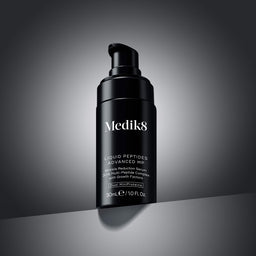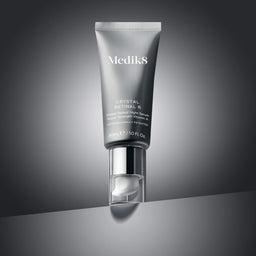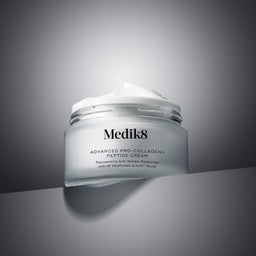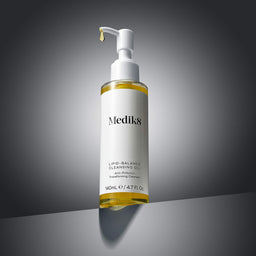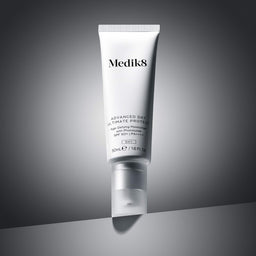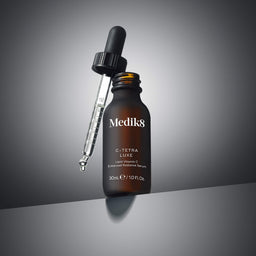Protecting your skin from the sun is one of the most important tools you can use to prevent premature ageing. That’s why sunscreen is one third of our CSA philosophy - vitamin C and sunscreen by day, and vitamin A at night. Together, the three elements form a simple yet fundamental foundation for the rest of your skincare journey.
Sunscreens are designed to protect from UV rays. UV rays are a type of light emitted from the sun - it is the highest energy ray derived from the sun and therefore can have the most damaging effect on our skin. In fact, up to 80% of skin ageing is caused by sun exposure (UVA + UVB).[1]
The sun’s rays are also made up of two other types of light rays; visible and infrared rays. The most concerning form of these rays is blue light, a type of visible light which is also referred to as High Energy Visible Light (HEVL). Its high energy makes it a concern; when delivered in high enough doses it can cause damage to our skin. Hence in our Medik8 Advanced Sunscreen line we specifically protect our skin from blue light damage.

POTENTIAL NEGATIVE EFFECTS OF BLUE LIGHT:
- Premature signs of skin ageing (fine lines and wrinkles)
- Free radical damage to skin cells
- Loss of skin supplety and plumpness
- Hyperpigmentation
Blue light has been found to cause free radical damage, which as we know, is a huge factor in causing premature signs of skin ageing. It has also been found to trigger the production of MMPs (matrix metalloproteinase), the main enzymes involved in the degradation of collagen and elastin.[2] This can lead to loss of elasticity, evident in fine lines and wrinkles across the complexion.
Blue light has also been found to induce hyperpigmentation in deeper skin tones, more significantly than UVB light-induced pigmentation when compared.[3] In lighter skin tones, blue light can cause erythema (sunburn) when delivered in combination with UVA rays.[4]
Blue light derived from screen time is negligible;
You don’t need to worry too much about blue light exposure from your iPhone
SUN VS SCREEN TIME: SOURCES OF BLUE LIGHT DAMAGE
So you may be wondering when you need to apply blue light protection to your skin to protect from its potential damaging effects. There is a lot of conversation around blue light and screen time, especially as we become more reliant on technology. However as Sunscreen Specialists, we recommend that the focus should be on protecting our skin from blue light emitted from the sun, rather than screens. Yes, we are saying you don’t need to worry too much about blue light exposure from your iPhone & you don’t need to wear sunscreen to scroll through instagram before bed. The majority of blue light which hits our skin is from the sun; therefore we need to prioritise protecting our skin from the sun. In comparison, the doses of blue light derived from screens is negligible. If you were to spend an entire week in front of a monitor uninterrupted at a distance of 30 cm from the screen, this would be the same level of damage as just one minute outside on a sunny summer day in Hamburg at midday.[5]
MEDIK8 SOLUTION TO BLUE LIGHT DAMAGE
At Medik8, we use two ingredients to protect from blue light, found in our Advanced Line of sunscreens.

Let's start with our blue light absorber blueberry seed oil, star of our environmental protection factors in our latest sunscreen/day cream hybrid Advanced Day Ultimate Protect. Sustainably sourced from 800,000 upcycled blueberries*, blueberry seed oil is a natural yet robust shield against blue light damage. Rich in antioxidant beta-carotene, it works to absorb blue light before it hits the skin. It has a very similar mechanism to a chemical sunscreen, but absorbing blue light instead of UV.
*Per 1kg of material

We also use theobroma cacao seed extract, found in sunscreens Advanced Day Total Protect and Advanced Day Eye Protect. This works to mitigate the negative effects of blue light, acting as an antioxidant to prevent free radical damage. It also helps to minimise damage to blue light photoreceptors in the skin.
Our Advanced Line of sunscreens all feature a 360 approach to environmental damage; harnessing anti-blue light, a pollution shield, infrared and glycation prevention to maximise protection and overall skin health. Shop the Advanced Line now.
REFERENCES
[1] F. Flament et al., Clinical, Cosmetic and Investigational Dermatology, 2013, 6, pp 221-232
[2] F. Liebel et al, Irradiation of Skin with Visible Light Induces Reactive Oxygen Species and Matrix-Degrading Enzymes, JID, 2012, 132(7), pp1901-1907.
[3] L. Duteil et al, Differences in visible light-induced pigmentation according to wavelengths: a clinical and histological study in comparison with UVB exposure., Pigment Cell Melanoma, Res, 2014, 27(5), pp 822-6
[4] I. Kohli et al, Impact of Long‐Wavelength Ultraviolet A1 and Visible Light on Light‐Skinned Individuals, Photochemistry and Photobiology, 2019, 95(6), pp 1285-1287.
[5] Batzer J, Eggers K, Kolbe L, Weise J. Assessment of hazard potential of high-energy visible light from electronic devices for the skin. Poster, 27th EADV Congress, Paris, France 2018, Poster No. P1672.
← Older Post Newer Post →
